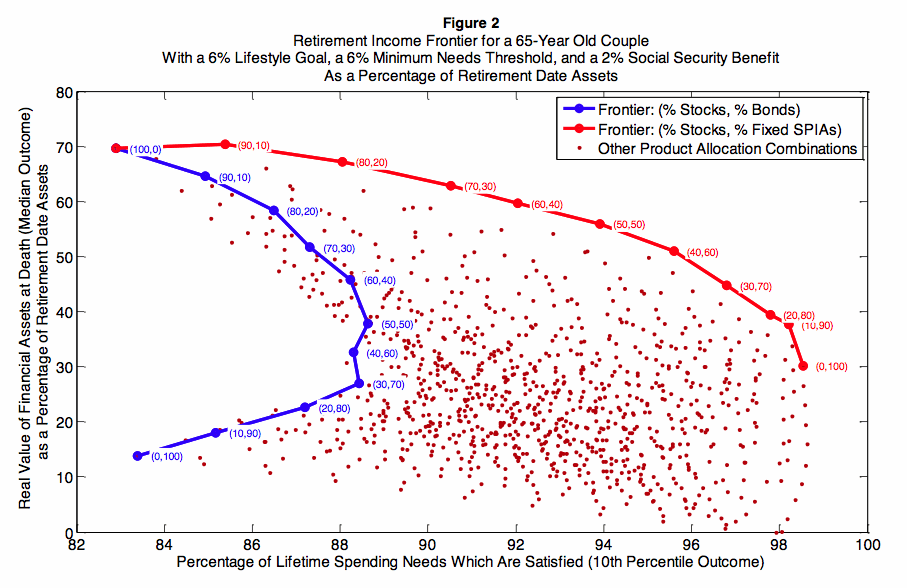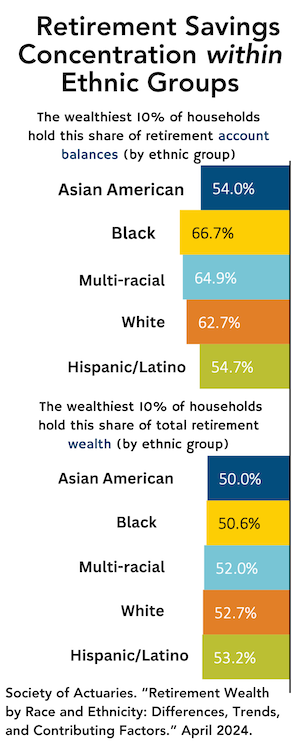
In the space of less than a year, it seems, Wade Pfau’s star has risen from that of an obscure lecturer in a Tokyo English-language university to someone who can pack a ballroom at a major Las Vegas casino. With fee-only financial advisors, that is.
On the strength of his meticulous research, Princeton Ph.D., and awards from the Journal of Financial Planning for his scholarly articles, the 30-something Pfau headlined the National Association of Personal Financial Advisors spring conference last week here in America’s R-rated Disneyworld.
He came to preach the wisdom of single-premium fixed income annuities (SPIAs), of all things. Traditionally, planners like income annuities as much as Sky Masterson likes church bingo. But Pfau’s ability to draw a crowd at the “Paris” resort may have been an indicator of growing advisor interest in guaranteed income. Or it may merely have reflected Pfau’s growing name-recognition.
The gist of Pfau’s presentation is illustrated by one of his slides, which you can see below. It shows that if a retiree’s goal is to satisfy lifetime spending needs while maximizing a legacy, substituting SPIAs for bonds in their traditional stock/bond portfolio can make a lot of sense.
[If you want the full text of Pfau’s argument, you can read this research paper, a later version of which appeared in the February 2013 issue of the Journal of Financial Planning.]

Forget the 4% rule, Pfau said. It’s not applicable to the real world. It’s based on U.S. market history alone, it’s based on the singularity of American economic performance in the 20th century alone, and it pretends that annuities are not an option.
Having looked at the numbers from many angles, Pfau strongly believes that life annuities can make an important contribution to most retirees’ portfolios—for their certitude, their mortality credit, and their ability to let retirees invest in equities with more peace of mind.
[When Pfau’s presentation ended, I asked the NAPFA member next to me what she thought. “I think it’s fantastic,” she said. “I’ve followed his work for years. It’s amazing that now he’s right up there with, with…” and she struggled to name a commensurate rock star in this space. I assume she meant Moshe Milevsky, Harold Evensky or Michael Kitces, to name just three possibilities.]
But there’s still the “annuicide” problem, she added. Putting a pen to a paper napkin, she illustrated the fact that if she moves 20% of her clients’ money to SPIAs, her compensation drops by 20%.
Which brings us to the factors or assumptions or anxieties that Pfau and his allies in academia decide to include or not include in their models and their analyses, but which advisors in the real world have to deal with every day, and which make them hesitant to put their clients in annuities. Annuicide is one of them. Others include:
The hyperinflation factor. That 1923 image of the German civilian pushing a wheelbarrow-full of Reichsmarks has remarkable staying power. Advisors worry a lot about hyperinflation. Unlike Pfau, they don’t think the bond market is correctly pricing future inflation risk. They believe Ben Bernanke has his thumb on the scale. Interestingly, Pfau doesn’t recommend buying an inflation-indexed SPIA. In his efficient-frontier model, he seems to assume that SPIAs let retirees hold more stocks, and that equities serve as an inflation hedge.
The unhappy client. In the distribution world, there’s always disintermediation risk. When clients are nervous about the markets, they phone their advisors and worry out loud. Clients may have a strong desire to sell what they have and buy something else. They may regret the annuity purchase and blame the advisor. The client factor sometimes eludes academics.
Issuer risk. A major advisor concern about annuities is the risk that the insurance company, the counterparty, might go out of business. Insurers may find it odd that advisors have more faith in common stocks than in AA-rated diversified financial services companies that happen to issue SPIAs, but they do. For advisor and client, a risky but liquid asset can feel safer than a “guaranteed” but illiquid asset. Note to insurers: Advisors know that some of your firms got TARP money in the crisis, and it has affected the entire life insurance industry’s reputation.
Annuity stigma. In concept, annuities have a place in every retirement advisor’s toolbox. In practice, annuities have a bad reputation, thanks to years of pushy, commission-based selling that resulted in ugly media coverage. For that reason alone, many fee-only advisors don’t want even to investigate annuities of any kind. That’s a shame, because many of them evidently don’t know that today’s annuities can be customized to solve a wide range of client needs.
Lack of knowledge of annuities. Most investment-oriented or accumulation-oriented advisors and clients know very little about annuities. Few understand the mortality credit and they usually discount the value of transferring longevity risk to a life insurer.
Pride of craftsmanship. Showing any sort of packaged financial product to a serious financial planner is like showing a piece of ready-made furniture to a master woodworker. One of his or her first thoughts is likely to be: “I can build that better myself, and cut out both the manufacturer’s overhead and the middleman.” This may be short-sighted. For one thing, it’s difficult to buy longevity risk protection without buying a life insurer’s products. For another thing, advisors like Curtis Cloke have shown that annuities offer lots of opportunity for creativity.
Legacy concern trumps longevity risk. The clients of successful planners are more likely to worry about their ability to afford to leave a sizable legacy than about running low on money before they die. Hence they don’t need annuities. One of Pfau’s points, however, is that it’s easier to maximize a legacy with life annuities than without them, because they allow clients to take more risk with their non-annuitized assets.
No difference between luxuries and necessities. As Pfau mentioned in his presentation, Kitces and others have written that high-net-worth retirees don’t distinguish between discretionary and non-discretionary needs. They may see no significant difference between luxuries and necessities, between wants and needs.
For them, the threshold for retirement portfolio success or failure is therefore higher—it must produce an income that supports their “lifestyle” instead of just their hypothetical survival needs. The need to establish a precautionary income “floor,” which annuities can address, may mean little to them.
Interestingly, Pfau concedes this point for the sake of discussion, and his data shows that SPIAs help just as much in helping clients meet that higher threshold as they do in helping them avoid the lower one.
A final note: In response to her concern about annuicide, I told the advisor next to me at Pfau’s presentation about the Cannex-Retirement Income Industry Association initiative to allow advisors to charge a reduced asset management fee on the present value of the SPIAs their clients own.
© 2013 RIJ Publishing LLC. All rights reserved.


